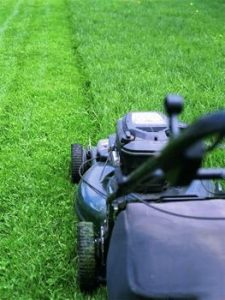
Lawn mowing
All lawns need mowing; it is one of the most frequent, and most important, tasks in maintaining a healthly lawn. Getting the cutting height and mowing frequency right can make a huge difference to the ongoing health of the lawn.
When to mow
Mowing is carried out mainly between March and October.
- Over summer: On average, mow twice weekly, dropping to once a week during periods of drought.
- Over spring and autumn: Mow once a week.
- Over winter: Mowing is usually not necessary, unless the weather is mild and the grass is still growing. In this case, mow occasionally with a high cut setting. Do not attempt to do this if the ground conditions are very soft or frozen, or during spells of cold, drying winds.
Dry and shady areas under trees may need less frequent mowing than areas in full sun with good moisture levels.
Never mow wet or frosty grass, as this can damage the turf and compact the soil. Wait until later in the day when the lawn has dried out or defrosted, or postpone mowing to another day.
How to mow
Mowing itself is relatively straight forward. It is the mowing height that can cause problems. Follow these tips to get the correct height:
For the first mowing in spring, set the cutting height to the highest setting.
Thereafter, gradually reduce the height of cut until the desired height is reached.
For fine lawns, this will be 6-13mm (¼-½in). For ordinary ornamental lawns this will be 13-25mm (½-1in) in summer and up to 40mm (1.5in) in spring and autumn.
Avoid excessively close mowing, as although attractive, it can weaken the grass, encouraging shallow rooting and making the lawn more susceptible to drought, weeds and moss. Close mown lawns need more frequent feeding and watering.
Extremely low cutting may scalp the lawn, leaving bare patches where there are bumps or tree roots protruding above the surface.
On the other hand, lawns regularly cut too high can suffer from loose, weak growth that is less durable as a surface.
If you are unsure of what height to use, the general guideline is never remove more than one-third of the leaf shoots in any one mow.
Getting a striped finish
A striped lawn looks very impressive, and isn’t that difficult to achieve if your mower has a rear roller. Wheeled rotary mowers do not produce good quality striping. Rectangular lawns are easier to stripe than irregularly shaped lawns, but with a bit of practice, you can stripe up any lawn.
Start by mowing around the edge of the lawn.
For square or rectangular lawns, work from the left side, mowing up and down the lawn using the straight lawn edge as a guide to get a straight line.
For circular or irregular shaped lawns, line up the mower with a focal point to achieve an initial straight line across the widest point. This first straight line can be your guide for subsequent stripes.
At each turn, line up the mower so that the next mown stripe slightly overlaps the last.
Empty the clippings box regularly. A full box can deposit clumps of clippings on the lawn, spoiling the finish and clogging the mower.
Tight corners may need strimming or hand trimming with lawn shears, if they are too small or boxed in for the mower to reach.
It is a good idea to vary the direction of cut, alternating straight with diagonal stripes on different occasions, so that ruts do not form in lawn from going backwards and forwards in the same direction on numerous occasions.
Problems
Scalping of the lawn may occur:
On soft ground (when the wheels sink in).
On turns (if they are taken too fast).
If ruts in the lawn form from not varying the direction of cut.
If the height of cut is too low.
If the lawn surface is uneven, with bumps and hollows. These are best levelled out.
An uneven finish, with torn grass is usually caused by blunt blades. However it can also occur if the bottom and cylinder blades of a cylinder mower are incorrectly set. Consult your owner’s manual for details of setting the blades correctly. Ragged cuts can also occur when the grass has been left to get very long, when the mower is operated too fast, or when the cutting height is set to maximum.
In extended periods of summer drought, turf grasses turn brown and stop growing. This often looks a lot worse than it actually is, and the lawn will usually recover rapidly with renewed rainfall. It would take a severe drought to actually kill off the lawn.
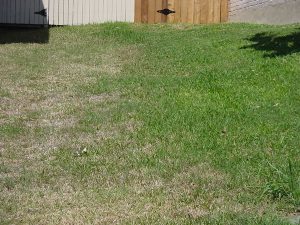
Lawn Care during drought
All lawns require special care measures during dry weather. When deprived of water, lawn grasses may stop growing and start to brown, especially once the top 10cm (4in) of soil dries out.
Ornamental lawns of fine bent-type grasses are most likely to suffer. General garden lawns containing fescue grasses may have more resistance.
A well-maintained lawn usually recovers rapidly with the onset of autumn rainfall, especially if appropriate autumn lawn care is given.
However, in extended periods of drought, or where the lawn is not well maintained, lawn grasses can become weakened and their roots deteriorate. If the grass becomes sparse, weeds and moss easily establish with the onset of autumn rains. Remedial action may be necessary.
If summers become hotter and drier, as predicted, the issue of caring for lawns in drought will become more pressing, as water may be too scarce for lawns to be watered.
Watering
Water newly created lawns thoroughly – provided there are no hosepipe restrictions in force.
For established lawns that must be kept green, water once the soil becomes dry, but before the grass colour changes. If the ground is very hard, aerate it by spiking with a garden fork before watering, to aid water penetration.
Water the lawn in early morning, evening or even night-time, to reduce water wastage from evaporation.
Watering once every seven to 10 days is normally sufficient. It is important not to apply too much water. This is wasteful, encourages shallow rooting of the grass and promotes moss and turf diseases. Excessive watering makes the lawn less drought-tolerant in case of hosepipe bans or holidays when watering is discontinued.
Ensure that the water reaches a depth of 10cm (4in) after each watering. Use a trowel to open a small test hole a few hours later to ensure the soil is sufficiently damp. By noting the duration of watering required to achieve this level of dampness, future irrigation can be more accurately applied.

Pests
The management of a lawn will occasionally require the control of lawn pests. In this section we try to provide you with some knowledge of the most common lawn pests.
Leather Jacket
Leatherjackets are the soil-dwelling larvae of flies known as crane flies or daddy-longlegs.
Symptoms
How to tell if leatherjackets are a problem in your garden;
Lawns develop patches where the grass turns yellowish brown and often dies. This can be distinguished from similar effects caused by lawn diseases or adverse growing conditions by lifting the affected turf and finding leatherjackets in the surface layers of the soil
Leatherjackets may also be revealed in lawns by soaking it with water and covering it with material impervious to light, such as sacking or black polythene. The following day large numbers of grubs should be found on the surface under the cover
Crows, magpies, rooks and starlings will search for leatherjackets in turf. These birds leave small round holes in the turf where they have inserted their beaks. They will also search for chafer grubs in a similar manner
Leatherjackets have elongate tubular bodies, up to 30mm long, and are greyish brown. They have no legs or obvious head
Control
Non-chemical control
A biological control is available for controlling leatherjackets in lawns, This is a pathogenic nematode, Steinernema feltiae, which is watered into the turf or soil. The nematodes enter the bodies of leatherjackets and infect them with a bacterial disease. To be effective, the nematode requires soil that is well drained but moist and with a minimum temperature of 12°C (54°F). The turf around the edge of affected areas should be targeted to deal with larvae spreading out from infestation “hot spots” in the lawn. However, by the time areas of infestation become apparent, the soil may be too cold for nematodes to be effective.
Chemical control
There are currently no chemical controls for leatherjackets on lawns.
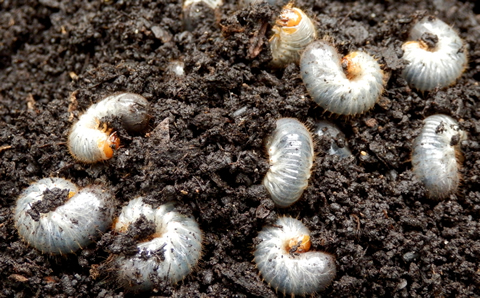
Chafer Grub
Chafer grubs are soil-dwelling larvae of chafer beetles. Depending on the species of chafer they either feed on decaying plant material or plant roots. Some, which are not considered pests are found in borders and compost heaps. However, several species that feed on the roots of grasses can cause problems in lawns.
Symptoms
Some species of chafer grub eat the roots of grasses and other plants. Evidence of their activities can be seen in a number of ways:
Damage to lawns is most obvious between autumn and spring when the grubs are reaching maturity
Patches of the lawn may become yellowish
Birds, particularly of the crow family (e.g. jays, magpies, rooks and crows), and badgers and foxes tear up turf in order to access the grubs to feed on them
Damaging infestations can be highly localised and sporadic
Chafer grubs can be found in the soil under the loose turf. They have stout white bodies curved in a C shape, light brown heads, with three pairs of legs at the head end. They are bigger than the adult beetles and, if straightened out, can be up to 18mm (almost ¾in) long
Other less troublesome species of chafer grubs can also occur in turf and garden borders, such as the cockchafer (Melolontha melolontha), summer chafer (Amphimallon solstitialis) and brown chafer (Serica brunnea). These can have larvae up to 30mm (over an inch)
Similar root damage in lawns can also be caused by leatherjackets but churning up of the turf by other animals is less likely where leatherjackets are the problem
Control
Non-chemical control
Repair damaged turf by re-sowing with grass seed or laying turf in April when the chafer grubs have moved deeper into the soil to pupate.
Poorly maintained lawns are more susceptible to damage, so attention paid to feeding, watering and moss prevention can help avoid damaging infestations
Areas can be treated with Pathogenic nematodes, usually Heterorhabditis bacteriophora, which attack the larvae by infecting them with a fatal bacterial disease. These microscopic animals can be watered into the lawn when the ground is moist and soil temperature range between 12-20ºC (55-68ºF). The turf around the edge of affected areas should be targeted to deal with larvae spreading out from infestation “hot spots”. However, by the time areas of infestation become apparent, the soil may be too cold for nematodes to be effective. As a preventive measure, apply nematodes in July to September.
Chemical control
There are currently no chemical controls for chafer grubs on lawns.

Animals
Dogs
Animals can have detrimental effects on turf. Dogs will trample the area if confined to a small space, and they must void their waste at some time. Apart from the smell and health implications it doesn’t look very nice either. If you have dogs we would be grateful if you could ensure your lawn is clear of any dog mess before we call. Bitches also cause patches of dead grass where they urinate, however if at all possible you can immediately dilute the area with a bucket of water this will greatly reduce the harmful effect dog urine has on grass.
Rabbits
Other pets such as rabbits and their wild cousins will scrape little holes.
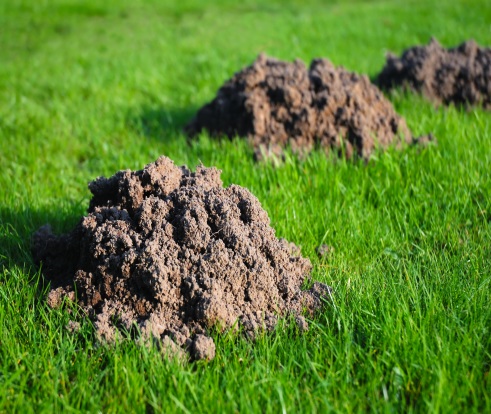
Moles
Moles are most unwelcome and can destroy a lawn, they are attracted by and feed on mostly earthworms but will also eat insects, larvae etc. Moles can be controlled by trapping or fumigating. If you have a problem with moles we recommend you consult with a licensed pest control expert.
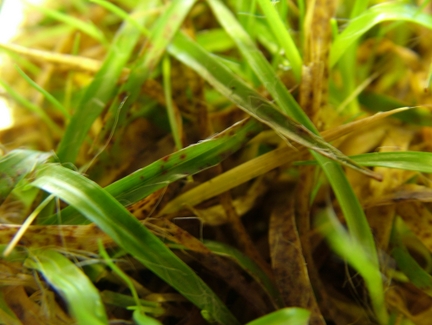
Turf Diseases
Turf diseases are usually caused by fungi invading plant tissues and robbing them of essential nutrients. Alternatively, they can be caused by fungi inhabiting the plants root zone and starving the plant of water and nutrients. However caused, turf diseases need to be dealt with in order to restore your lawn to full health.
There are many diseases which attack turf. Fortunately most of these diseases are found mainly in intensively managed turf where fine grass species have been used. Domestic lawns are usually created using Perennial Ryegrasses, this is because they have excellent resistance to wear and are tolerant of the climate in the UK. The main turf disease threats to domestic lawns are:
Lawn Rust Disease
Rust is a common foliar disease of turf. It is caused by various fungi, usually Puccinia or Uromyces species. Infected areas may produce huge numbers of air-borne spores.
Symptoms
Typical symptoms of lawn rust include;
Affected patches of grass turn yellow
Large numbers of tiny, spore-producing pustules break through the leaf surface. The colour of the pustule will depend on the species of rust and the type of spore it is producing. Most commonly the pustules are orange, but in autumn the fungus may switch to producing black pustules containing over-wintering spores
When walking over an affected lawn, shoes or clothes turn orange as they become coated with vast numbers of spores
Severely affected leaves may turn brown and shrivel, but the rust does not usually kill the grass
Control
Non-chemical control:
Feed the lawn regularly during the growing season to maintain vigour
Avoid high nitrogen fertilisers in the autumn, as the resultant lush growth may be more prone to attack by rust and other diseases such as Fusarium patch
Mow regularly to reduce the number of affected leaves, removing the clippings
Improve air circulation by selective pruning of overhanging trees and shrubs
Chemical Control:
There are no fungicides available to gardeners for the control of rust on lawns. Chemical control of rust is usually unnecessary, however, as the symptoms are temporary. Even lawns that are heavily infected in autumn will usually produce healthy growth by early summer of the following year.
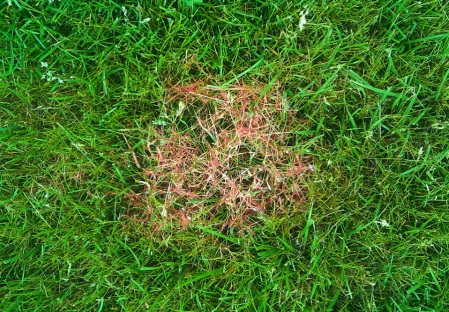
Red Thread
Red thread is a common cause of patches of dead grass on lawns during wet summers and in autumn. It is caused by the fungus Laetisaria fuciformis. Red thread will rarely kill the grass completely, and the patches will recover with appropriate remedial action. The disease can develop at any time of year, but is most common in late summer and autumn.
It is most serious on red fescue (Festuca rubra), but other fescues, bents (Agrostis spp.), perennial ryegrass (Lolium perenne) and annual meadow grass (Poa annua) are also attacked.
Symptoms
You may see the following symptoms:
Patches of affected grass with a reddish tinge at first, later becoming light brown or almost bleached in appearance
Patches vary in size from 7.5cm (3in) to 25cm (10in) in diameter but can be much larger
Two types of fungal growth may be seen on the patches, particularly under wet or humid conditions. Both are visible to the naked eye, but are seen better with a hand lens or magnifying glass.
The first takes the form of small, pink, cottony flocks, and can be confused with growth of the fungus causing snow mould
The second is specific to red thread, and gives the disease its common name. Pinkish-red, gelatinous, thread-like structures (stromata), 1-2mm (less than ¼in) in length, are produced on the leaves and may bind them together
Control
If red thread appears, application of nitrogen to the affected area will often be sufficient to control it.
The threat from red thread can be reduced by taking action to improve the drainage and aeration of the turf. Scarifying the turf will remove thatch and moss and increase aeration. Poor drainage and compacted areas can be alleviated aerating Ensure that the soil is not deficient in nitrogen. Disposing of (not composting) grass cuttings will reduce the amount of fungus present to re-infect the lawn.
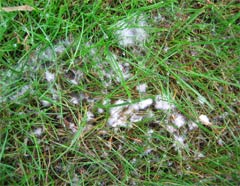
Fusarium patch
This disease is caused by the fungus Microdochium nivale. It is one of the most damaging diseases of turf grasses and can be difficult to control. It is found most frequently during autumn, winter and early spring, but attacks can occur at any time of the year.
The disease is sometimes very noticeable after thaws of snow, when it is given the common name of snow mould.
Fusarium patch is particularly troublesome on annual meadow grass (Poa annua), but can also affect bents (Agrostis species), fescues (Festuca species) and perennial rye-grass (Lolium perenne).
Symptoms
What to look out for;
The disease is first noticed as small patches of yellowish, dying grass that later turn brown
Patches increase in size and may reach 30cm (12in) or more in diameter, often merging together so that large areas can be affected
During wet conditions a white or pinkish, cottony fungal growth may be noticed, particularly at the margins of the patch. This is not to be confused with another fungal disease called red thread, or with slime moulds in turf
Control
Non-chemical control
Ensure that the lawn dries rapidly after dews or rainfall by improving the aeration and drainage. This can be done by a combination of scarifying, spiking and hollow- or solid tining
Improve general airflow over the lawn by pruning back overhanging trees or shrubs
Remove heavy dews in the morning with a switch or bamboo cane
Chemical control
The Sports Turf Research Institute recommends using iron sulphate, a mosskiller, to reduce the severity of the disease. This compound toughens the grass and has an acidifying effect on the turf, which in turn discourages snow mould.

Dry patch
Dry patch is just one of the many factors that can cause the appearance of dead patches in lawns. Other possibilities include insect pests, fungal diseases, spilt mower fuel, and dog or fox urine.
Dry soil due to prolonged hot, dry weather will also cause the grass to turn brown, but in this case there is usually good recovery once rain returns. However, with dry patch there is no recovery after rain as the water cannot penetrate the soil to reach the roots.
The causes of dry patch are complex and poorly understood, but a common cause is thought to be the coating of soil particles with water-repellent chemicals due to the growth of fungi.
Symptoms
You may see the following symptoms:
Patches or irregular areas of the lawn turn first a darker green colour, and then brown
The symptoms may develop during dry weather, but the problem does not improve with the return of rain or by watering the patches
The soil underneath the affected patches will be found to be completely dry. Any water applied will simply run off or sit on the surface of the soil
In extreme cases puddles may form on the surface following rainfall, as if the area is waterlogged, but the soil will still be bone-dry beneath
Occasionally there may be an obvious white growth of fungal mycelium visible, or a fungus-like smell to the thatch or soil
Control
Non-chemical control
To help prevent dry patch:
Scarify the lawn in autumn to remove accumulations of thatch
Avoid soil compaction, and improve water and air penetration to the roots by aerating the lawn.
Feed at the appropriate times to promote strong, healthy growth with a vigorous root system
If dry patch develops it can be very difficult to re-wet the soil, but the following may help:
Spike the area densely, and attempt to apply some water each day for a few days (don’t overwater as it will just run off)
Consider applying a wetting agent (see chemical control, below)
Repeat the treatment once a month for 3-4 months
In severe cases that do not respond to treatment, the affected turf plus three or four inches of soil may need to be removed, and the soil replaced before re-seeding or re-laying with fresh turf
Chemical control
Wetting agents are often used by sports turf professionals to treat dry patch. These are chemicals that aid the absorption of water by soil particles. Repeat treatment is likely to be necessary, in conjunction with the cultural methods outlined above.
An effective pest and disease control program firstly requires identification of the disease or the undesirable species and secondly the problem needs to be brought under control and eliminated. To control pests and disease turf Stripes Lawn Care use market leading products that will quickly and effectively deal with unwelcome turf pests and diseases.

Weeds
Weeds are the number one problem in lawns and are aggressive competitors for sunlight, moisture and nutrients and prolific multipliers even under adverse conditions.
In lawns weeds are often the result of poor quality turf, rather than the cause of poor turf. The aggressive nature of weeds and their prolific reproductive capacity enable them to invade thin, weak turf areas. Cultural practices should always be viewed as the first step to effective weed control. Always determine why weeds established a foothold and correct those deficiencies. If the basic problem is not corrected, weeds will continue to occur.
An effective weed control program also requires identification of the undesirable species as to its classification. Most turf weeds belong to two principal categories – grasses and broadleaf plants.
To control weeds in turf Stripes Lawn Care use market leading selective herbicides which have proven effectiveness against a wide range of broad leaved weeds in turf. Most weeds will be controlled by a single application, however certain species that have become hardened may be less susceptible and need re-treating.

Moss
Moss can be a temporary problem following drought or waterlogging, or more persistent, suggesting a problem with underlying conditions. On new lawns this may be due to poor site preparation. On established lawns poor vigour, acidic soil conditions, a lack of feed, insufficient aeration, poor drainage, shade, close mowing and over-use are likely to blame.
Killing and removing the moss is just the start. To remain moss-free, the grass must be improved and any other contributory factors addressed. Good autumn lawn maintenance is essential to maintaining lawn health.
If, despite remedial action, moss remains a problem, such as under trees or in a poorly-drained site, consider alternatives to grass.
Appearance
There are several types of moss that grow on lawns. These are usually coarse, loose, green or yellowish-green tufts between the grass, but can form densely matted tufts or, in the case of Polytrichum, appear like small forests of miniature Christmas trees.
Moss gives the turf an uneven colour and surface. Loose mosses make the lawn feel spongy to walk on.
Cause
Poor growing conditions favour the growth of moss in lawns. These might include:
- Sparse grass cover
- Worn areas of turf, especially along walkways and where children play
- Shady areas, especially beneath trees
- Compacted soil
- Wet weather and waterlogged conditions
- Drought-stressed grass
- Mowing too close
- Impoverished lawns or infertile soil
- Poorly prepared or poorly maintained lawns
- Acidic soil conditions
Chemical control
As part of our treatment programme Stripes Lawn Care apply a winter fertiliser through December and January, the purpose of this treatment is to harden the turf to make it more disease resistant, the treatment also keeps the turf green during the winter months and is a very effective way of controlling moss.
Moss prevention
Stripes Lawn Care’s treatment programme helps prevent moss establishing and thriving through a combination of regular fertiliser applications, aeration and scarifying.




